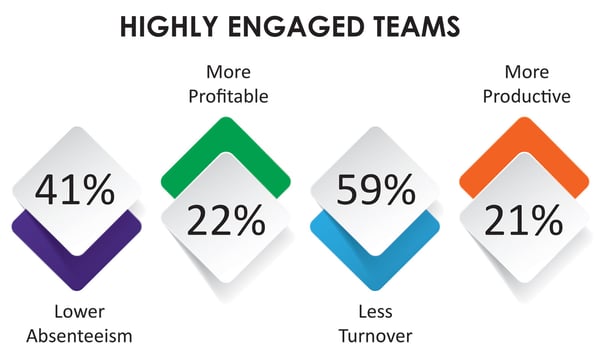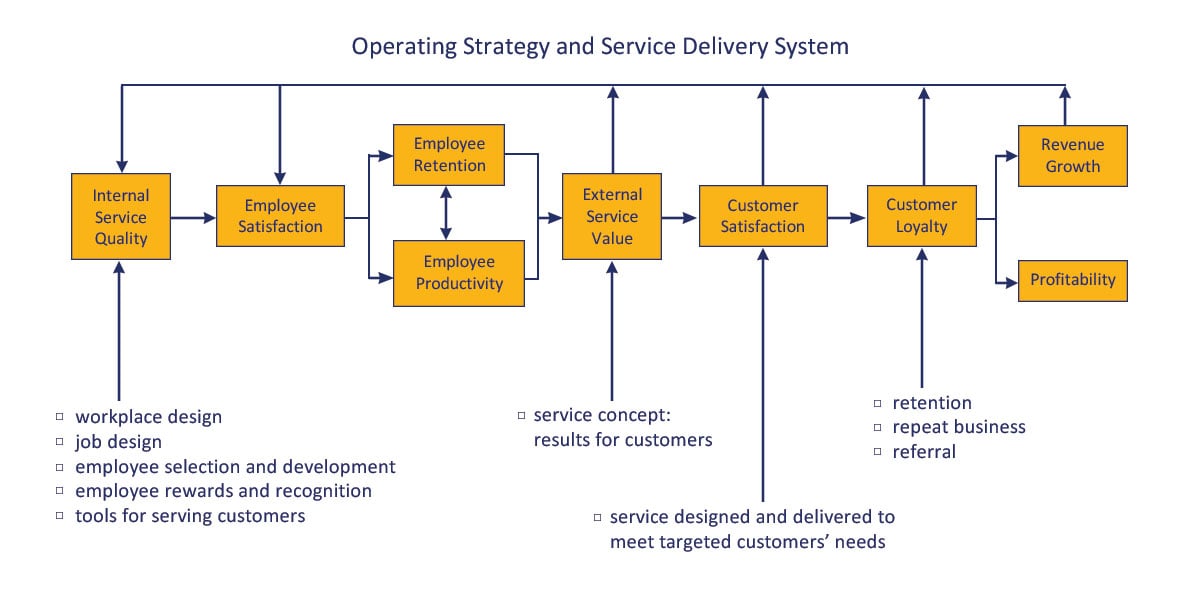|
By Shana Schlabach, Engagement Product Manager, MBA, SHRM-SCP - Service businesses are about people serving people, making labor the top issue across service industries. In our tight labor market, hiring has been a considerable challenge and turnover has reached crisis levels in many sectors. With replacement costs as high as an additional 21% of an employee’s annual salary, it’s no surprise that there has been a significant focus on engaging employees to drive loyalty and retention. The benefits of an engaged workforce go beyond reducing turnover. If you’re in hospitality, retail, healthcare, or any other labor-intensive service industry, your business is responsive to the service-chain profit model (Figure 1), which suggests that employee satisfaction ultimately leads to profitability – not only because retention reduces costs associated with turnover, but also because engaged employees are more productive and deliver higher quality service. If you want to optimize the productivity of your workforce, engagement is a requirement. Figure 1 – The Service-Profit Chain
This model has proven out in a number of recent studies on employee engagement. Gallup found that companies with highly-engaged teams are 22% more profitable. Teams that score in the top 20% in engagement are 21% more productive, with 41% lower rates of absenteeism, and 59% less turnover . It goes without saying that understanding how to drive employee engagement is clearly good business. A single Google search will surface hundreds of statistics and opinions on how to better engage your workforce. Most focus on understanding generational factors affecting staff members’ work values, with emphasis on what millennials want and expect from the workplace. Recommended activities range from corporate social responsibility initiatives to gamification that rewards desired behavior. The problem is, there is very little addressing the most critical issue for engagement: management. The role of managers in employee engagementYou’ve no doubt heard the saying, “people don’t leave jobs, they leave bosses.” Well, it’s true. The biggest determining factor affecting staff retention and engagement is employees’ relationships with their managers and perceptions of those managers’ leadership. According to Gallup’s chief scientist for workplace management, James K. Harter, Ph.D., at least 75% of the reasons for voluntary turnover can be influenced by managers and managers account for as much as 70% of variance in employee engagement. The converse is also true. Staff who are satisfied with their managers show higher levels of engagement. A recent study reported in the Journal of Human Resources in Hospitality & Tourism found that as satisfaction increases with their direct leader, employee engagement increases. A one-point increase in leadership satisfaction results in a 36% increase in engagement. The challenge is that retention and engagement is not only an issue with operational staff. Managerial turnover in the US ranges between 35% - 47%, as compared to 8% - 15% in non-service industries, and costs of replacing and training a new manager run as high as 170% of his or her annual salary. So, the key to engaging your staff goes beyond improving your managers’ skills, you first have to retain them. Unfortunately, very little attention has been given to understanding how best to engage and support managers, despite the fact that this should clearly be the first priority for every service business in their employee engagement efforts. 
What your managers needManagers’ workloads in service industries have increased as staff turnover and hiring challenges require them to not only manage, but often to do the actual work when they are short-staffed. As big data and analytics have become a priority at the corporate level, managers are required to spend more time on reporting. Even functions like forecasting, scheduling, and day-to-day timekeeping have become more time consuming as legislation drives increasingly cumbersome work rules and higher labor costs place additional pressure on managers to figure out how to improve productivity without negatively affecting customers. These managers joined a service business because they want to serve and interact with people, yet their workload grows with tasks that require them to spend more time at their desks. At the same time, the burden of corporate employee engagement programs falls on managers’ shoulders. They understand that they need relationships with their staff based on open communication, trust, and confidence, but sometimes they aren’t sure how to get there. Most of their training has been focused on administrative and logistical functions of day-to-day management. Lack of training and coaching in people management is compounded by the complexities of today’s multi-generational workforce. While most managers are capable of figuring out how to manage through these challenges, they simply don’t have enough time or the right resources. Manager burnout has become a common issue across industry sectors, with 73% of healthcare leaders and more than 80% of hospitality managers reporting that they are experiencing at least some degree of burnout. The primary reasons given for stress and burnout are workload and work content. It isn’t that managers don’t want to work hard. In fact, according to a study focused on retaining management by Cornell University School of Hotel Administration, a key factor for job satisfaction is “challenging work”. They are willing to put in tremendous effort for work that is interesting, provides ongoing opportunities to learn new skills and develop professionally, and offers opportunity for job growth. Investing in manager engagementIt’s clear that investment in engaging management has very strong benefits – and that managers in service industries are facing significant challenges. There are some key investments that will go a long way toward increasing engagement with managers, which may seem obvious, but are missing or inadequate in many service businesses.
....very little attention has been given to understanding how best to engage and support managers, despite the fact that this should clearly be the first priority... Give them tools that give back their time
With today’s technology, many administrative functions can be automated. More complex functions like demand forecasting can be executed in a fraction of the time, with a level of precision that would take hours do with a spreadsheet. Schedules that align with forecasted demand patterns can be generated and rostered in minutes, giving managers back time that might be spent behind a desk and putting them back on the floor with staff and customers. Adopting more advanced workforce management systems is a significant investment, but they give managers back precious hours every week and empower them with real-time data, helping them make better decisions throughout the day. When they can see what is happening and take action before things like overtime become a problem, they aren’t caught later dealing with time consuming issues like rearranging schedules. Keep them – and their teams – mobileThe power of mobile technology to connect managers to their teams for easier communication is clear – and important – but that is only part of their power. When a manager can address schedule requests via their mobile devices, connect with ease to their available team members when someone calls out, and know exactly who is on the clock or late to clock in no matter where they are, they have a greater sense of control and autonomy. They manage better. They eliminate lost paper requests and notes from staff, which can be a blow to trust. And they are happier. It is surprising to see how many labor-intensive service businesses have either failed to adopt mobile technologies entirely or are satisfied with simple messaging apps. Invest in mobile applications that give managers the ability to manage from anywhere and you will see their engagement and productivity improve rapidly. Train them – continuouslyTraining is important to managers in any industry. It indicates a clear commitment on the part of the company to not only help them do their jobs better, but also to help them grow professionally. Ensure that your training comprises four areas:
These are not insignificant commitments, but the facts show that engagement starts with managers and rolls downhill. Companies that consider investments in tools and training as strategic will benefit from happier customers and more profitable operations.
1Rigoni, B., & Nelson, B. (August 9, 2016). Many millennials are job-hoppers–but not all are. Gallup: Workplace. Retrieved from https://www.gallup.com/workplace/236294/millennials-job-hoppers-not.aspx 2Heskett, Jones, Loveman, Sasser, Schlesinger. (July/August 2008). Putting the Service Profit Chain to Work. Harvard Business Review. Retrieved from https://hbr.org/2008/07/putting-the-service-profit-chain-to-work 3Sorenson, S. (June 20, 2013). How Employee Engagement Drives Growth. Gallup: Workplace. Retrieved from https://www.gallup.com/workplace/236927/employee-engagement-drives-growth.aspx 4Clifton, J (2017). State of the American Workplace. Washington, DC: Gallup, Inc. 5Robison, J. (May 8, 2008) Turning Around Employee Turnover. Gallup Business Journal. (Retrieved from https://news.gallup.com/businessjournal/106912/turning-around-your-turnover-problem.aspx) 6Beck, R. & Harter, J. (April 21, 2015) Managers Account for 70% of All Variance in Employee Engagement. Gallup Business Journal. (Retrieved from https://news.gallup.com/businessjournal/182792/managers-account-variance-employee-engagement.aspx) 7Book, L, Gatling, A & Kim, J (May 24, 2019) The effects of leadership satisfaction on employee engagement, loyalty, and retention in the hospitality industry, Journal of Human Resources in Hospitality & Tourism, 18:3, 368-393, DOI:10.1080/15332845.2019.1599787 8Lagasse, J. (July 3, 2018). Almost three-quarters of healthcare leaders feel some degree of burnout, survey finds. Healthcare Finance (Retrieved from https://www.healthcarefinancenews.com/news/almost-three-quarters-healthcare-leaders-feel-some-degree-burnout-survey-finds) 9Paychex. (February 25, 2019). Feeling the Burn(out): Exploring How Employees Overcome Burnout. (Retrieved from https://www.paychex.com/articles/human-resources/impact-of-employee-burnout) 10Taylor, M. S., & Walsh, K. (2005). Retaining management talent: What hospitality professionals want from their jobs [Electronicarticle]. Cornell Hospitality Report, 5(1), 6-29 |


